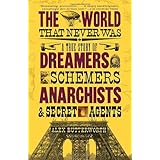
Average Reviews:

(More customer reviews)The Paris Commune is a fascinating topic, and Butterworth gives it several chapters. Then he goes through the next fifty years, ending with 1932, when Hitler and Roosevelt came into power, almost glossing over the period in the nearly 400 pages left. Cons: he introduces a new person about every three paragraphs, then spends little time filling out the details on most of them; anarchists (and those who were called anarchists) during this period committed many notable crimes that are mileposts of recent history, but does Butterworth spend any time building anticipation for and understanding of the significance of the these acts? No. Where is the discussion of the ideals and philosophy of anarchism and socialism? Where are the Internationals? He talks about them a little, not much. Where's the elder Ulyanov brother and the attempts on the life of Alexander III? He and they are mentioned in passing. There's almost no discussion of the idealism of anarchism, namely, the assumption that people are Rousseauvian, capable of attaining socio/political paradise, and not much discussion of the reaction to anarchistic plots to blow people up. There are occasional morsels of moral philosophy as the foundation for anarchism and anarchistic violence, but very little, just enough to whet your appetite then leave you unrewarded. Butterworth talks about explosives as the anarchists became acquainted with them, but he doesn't say much about them, although he starts to as he discusses more and more explosive substances, so he neither avoids that subject nor deals with it in any detail, so there's not much to the nuts and bolts of the bomb-throwing aspect of anarchism. Some important moments in anarchism are neglected: Haymarket is quickly glossed over; where's the Siege of Sidney Street? Where are the great strikes? Homestead is in the book, but there are no conclusions drawn, historical, philosophical, political, or otherwise. There's nothing about the IWW or the Lawrence and Paterson anarchosyndicalist strikes. Henry Frick is there, but very little about his role in the history of the American labor movement. Butterworth talks a bit about the narodniki, but he doesn't say much about what their ideas were or their motivation to assassinate the tsar, although he talks about the frustration following the emancipation of the serfs. And the book is so densely written (not in any good sense, be advised) that it's a struggle to read through it. You would think that a book that deals with a multitude of vivid personalities and their high-profile crimes, carried out with alleged high ideals in mind would tell one engrossing story after another. Afraid not; the book clanks with long, convoluted, compound sentences that require more than one reading in many cases, but fails to provide the reader with a motivation to read them more than once. Pluses: the book deals with the shadows thrown in the dark corners of the Gilded Age and it talks in interesting detail about the Paris Commune, although once you've finished the book, if you didn't know what happened, you'd never know that the Prussians invaded France in 1870. There's a bit of interesting information about socialist communes in Kansas in the 1870s and anarchist exile in French New Caledonia; you get to know a bit more about some of the famous anarchists such as Kropotkin, Bakunin, Louis Lingg, and so on. But Butterworth spends an inordinate amount on the police infiltrators. Poor Louise Michel, with that bullet in her head. But where are Emma Goldman (given short shrift), Louise Bryant, Mother Jones, the founders of the IWW before they were the IWW, Big Bill Haywood, Daniel DeLeon? Where are the famous English anarchists? No Fabians discussed? Not much to see of them. Where's Edouard Bernstein? Lenin, Leibknecht, Rosa Luxemburg? Look for them in vain.
Click Here to see more reviews about: The World That Never Was: A True Story of Dreamers, Schemers, Anarchists, and Secret Agents (Vintage)

0 comments:
Post a Comment